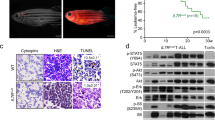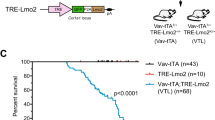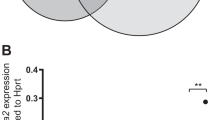Abstract
The t(3;21) chromosomal translocation seen in blastic crisis of chronic myeloid leukemia and secondary leukemias results in a formation of a chimeric protein AML1-Evi-1, which suppresses wild-type AML1 function. Loss of AML1 function causes expansion of hematopoietic progenitor cells, whereas it is not sufficient for the development of leukemia. To identify essential mechanisms through which AML1-Evi-1 exerts full leukemogenic potential, we introduced AML1-Evi-1 and its mutants in murine bone marrow cells, and evaluated their transforming activities by colony replating assays. The transforming activity of AML1-Evi-1 was lost when any of the known functional domains of Evi-1 was deleted from the chimeric protein, and forced expression of Evi-1 did not transform the AML1-deleted bone marrow cells. Unlike the MLL-ENL and AML1-ETO leukemia-related chimeric proteins, AML1-Evi-1 could transform only the hematopoietic stem cell fraction. Moreover, AML1-Evi-1-transformed cells show a cell-marker profile distinct from that of the cells transformed by AML1-ETO, which also suppresses AML1 function. Thus, leukemogenic activity of AML1-Evi-1 may be due to activation of molecular mechanisms distinct from those activated by MLL-ENL or AML1-ETO in the hematopoietic stem cell fractions.
This is a preview of subscription content, access via your institution
Access options
Subscribe to this journal
Receive 12 print issues and online access
$259.00 per year
only $21.58 per issue
Buy this article
- Purchase on Springer Link
- Instant access to full article PDF
Prices may be subject to local taxes which are calculated during checkout





Similar content being viewed by others
References
Miyoshi H, Shimizu K, Kozu T, Maseki N, Kaneko Y, Ohki M . t(8;21) breakpoints on chromosome 21 in acute myeloid leukemia are clustered within a limited region of a single gene, AML1. Proc Natl Acad Sci USA 1991; 88: 10431–10434.
Erickson P, Gao J, Chang KS, Look T, Whisenant E, Raimondi S et al. Identification of breakpoints in t(8;21) acute myelogenous leukemia and isolation of a fusion transcript, AML1/ETO, with similarity to Drosophila segmentation gene, runt. Blood 1992; 80: 1825–1831.
Nucifora G, Begy CR, Kobayashi H, Roulston D, Claxton D, Pedersen-Bjergaard J et al. Consistent intergenic splicing and production of multiple transcripts between AML1 at 21q22 and unrelated genes at 3q26 in (3;21)(q26;q22) translocations. Proc Natl Acad Sci USA 1994; 91: 4004–4008.
Mitani K, Ogawa S, Tanaka T, Miyoshi H, Kurokawa M, Mano H et al. Generation of the AML1-EVI-1 fusion gene in the t(3;21)(q26;q22) causes blastic crisis in chronic myelocytic leukemia. EMBO J 1994; 13: 504–510.
Tanaka T, Mitani K, Kurokawa M, Ogawa S, Tanaka K, Nishida J et al. Dual functions of the AML1/Evi-1 chimeric protein in the mechanism of leukemogenesis in t(3;21) leukemias. Mol Cell Biol 1995; 15: 2383–2392.
Zent CS, Mathieu C, Claxton DF, Zhang DE, Tenen DG, Rowley JD et al. The chimeric genes AML1/MDS1 and AML1/EAP inhibit AML1B activation at the CSF1R promoter, but only AML1/MDS1 has tumor-promoter properties. Proc Natl Acad Sci USA 1996; 93: 1044–1048.
Growney JD, Shigematsu H, Li Z, Lee BH, Adelsperger J, Rowan R et al. Loss of Runx1 perturbs adult hematopoiesis and is associated with a myeloproliferative phenotype. Blood 2005; 106: 494–504.
Ichikawa M, Asai T, Saito T, Seo S, Yamazaki I, Yamagata T et al. AML-1 is required for megakaryocytic maturation and lymphocytic differentiation, but not for maintenance of hematopoietic stem cells in adult hematopoiesis. Nat Med 2004; 10: 299–304.
Putz G, Rosner A, Nuesslein I, Schmitz N, Buchholz F . AML1 deletion in adult mice causes splenomegaly and lymphomas. Oncogene 2006; 25: 929–939.
Meyers S, Lenny N, Hiebert SW . The t(8;21) fusion protein interferes with AML-1B-dependent transcriptional activation. Mol Cell Biol 1995; 15: 1974–1982.
Yuan Y, Zhou L, Miyamoto T, Iwasaki H, Harakawa N, Hetherington CJ et al. AML1-ETO expression is directly involved in the development of acute myeloid leukemia in the presence of additional mutations. Proc Natl Acad Sci USA 2001; 98: 10398–10403.
Rhoades KL, Hetherington CJ, Harakawa N, Yergeau DA, Zhou L, Liu LQ et al. Analysis of the role of AML1-ETO in leukemogenesis, using an inducible transgenic mouse model. Blood 2000; 96: 2108–2115.
Higuchi M, O'Brien D, Kumaravelu P, Lenny N, Yeoh EJ, Downing JR . Expression of a conditional AML1-ETO oncogene bypasses embryonic lethality and establishes a murine model of human t(8;21) acute myeloid leukemia. Cancer Cell 2002; 1: 63–74.
Cuenco GM, Nucifora G, Ren R . Human AML1/MDS1/EVI1 fusion protein induces an acute myelogenous leukemia (AML) in mice: a model for human AML. Proc Natl Acad Sci USA 2000; 97: 1760–1765.
Senyuk V, Chakraborty S, Mikhail FM, Zhao R, Chi Y, Nucifora G . The leukemia-associated transcription repressor AML1/MDS1/EVI1 requires CtBP to induce abnormal growth and differentiation of murine hematopoietic cells. Oncogene 2002; 21: 3232–3240.
Nitta E, Izutsu K, Yamaguchi Y, Imai Y, Ogawa S, Chiba S et al. Oligomerization of Evi-1 regulated by the PR domain contributes to recruitment of corepressor CtBP. Oncogene 2005; 24: 6165–6173.
Kurokawa M, Mitani K, Irie K, Matsuyama T, Takahashi T, Chiba S et al. The oncoprotein Evi-1 represses TGF-beta signalling by inhibiting Smad3. Nature 1998; 394: 92–96.
Kurokawa M, Mitani K, Yamagata T, Takahashi T, Izutsu K, Ogawa S et al. The evi-1 oncoprotein inhibits c-Jun N-terminal kinase and prevents stress-induced cell death. EMBO J 2000; 19: 2958–2968.
Tanaka T, Nishida J, Mitani K, Ogawa S, Yazaki Y, Hirai H . Evi-1 raises AP-1 activity and stimulates c-fos promoter transactivation with dependence on the second zinc finger domain. J Biol Chem 1994; 269: 24020–24026.
Chakraborty S, Senyuk V, Sitailo S, Chi Y, Nucifora G . Interaction of EVI1 with cAMP-responsive element-binding protein-binding protein (CBP) and p300/CBP-associated factor (P/CAF) results in reversible acetylation of EVI1 and in co-localization in nuclear speckles. J Biol Chem 2001; 276: 44936–44943.
Palmer S, Brouillet JP, Kilbey A, Fulton R, Walker M, Crossley M et al. Evi-1 transforming and repressor activities are mediated by CtBP co-repressor proteins. J Biol Chem 2001; 276: 25834–25840.
Izutsu K, Kurokawa M, Imai Y, Maki K, Mitani K, Hirai H . The corepressor CtBP interacts with Evi-1 to repress transforming growth factor beta signaling. Blood 2001; 97: 2815–2822.
Kurokawa M, Mitani K, Imai Y, Ogawa S, Yazaki Y, Hirai H . The t(3;21) fusion product, AML1/Evi-1, interacts with Smad3 and blocks transforming growth factor-beta-mediated growth inhibition of myeloid cells. Blood 1998; 92: 4003–4012.
Izutsu K, Kurokawa M, Imai Y, Ichikawa M, Asai T, Maki K et al. The t(3;21) fusion product, AML1/Evi-1 blocks AML1-induced transactivation by recruiting CtBP. Oncogene 2002; 21: 2695–2703.
Cuenco GM, Ren R . Both AML1 and EVI1 oncogenic components are required for the cooperation of AML1/MDS1/EVI1 with BCR/ABL in the induction of acute myelogenous leukemia in mice. Oncogene 2004; 23: 569–579.
Cozzio A, Passegue E, Ayton PM, Karsunky H, Cleary ML, Weissman IL . Similar MLL-associated leukemias arising from self-renewing stem cells and short-lived myeloid progenitors. Genes Dev 2003; 17: 3029–3035.
Huntly BJ, Shigematsu H, Deguchi K, Lee BH, Mizuno S, Duclos N et al. MOZ-TIF2, but not BCR-ABL, confers properties of leukemic stem cells to committed murine hematopoietic progenitors. Cancer Cell 2004; 6: 587–596.
Meyers S, Downing JR, Hiebert SW . Identification of AML-1 and the (8;21) translocation protein (AML-1/ETO) as sequence-specific DNA-binding proteins: the runt homology domain is required for DNA binding and protein–protein interactions. Mol Cell Biol 1993; 13: 6336–6345.
Ono R, Nakajima H, Ozaki K, Kumagai H, Kawashima T, Taki T et al. Dimerization of MLL fusion proteins and FLT3 activation synergize to induce multiple-lineage leukemogenesis. J Clin Invest 2005; 115: 919–929.
Kurokawa M, Ogawa S, Tanaka T, Mitani K, Yazaki Y, Witte ON et al. The AML1/Evi-1 fusion protein in the t(3;21) translocation exhibits transforming activity on Rat1 fibroblasts with dependence on the Evi-1 sequence. Oncogene 1995; 11: 833–840.
Senyuk V, Li D, Zakharov A, Mikhail FM, Nucifora G . The distal zinc finger domain of AML1/MDS1/EVI1 is an oligomerization domain involved in induction of hematopoietic differentiation defects in primary cells in vitro. Cancer Res 2005; 65: 7603–7611.
Deguchi K, Ayton PM, Carapeti M, Kutok JL, Snyder CS, Williams IR et al. MOZ-TIF2-induced acute myeloid leukemia requires the MOZ nucleosome binding motif and TIF2-mediated recruitment of CBP. Cancer Cell 2003; 3: 259–271.
Acknowledgements
We thank SW Hiebert for AML1-ETO cDNA, T Kitamura for MLL-ENL cDNA, R Kühn and J Takeda for Mx-cre transgenic mice, Kirin Brewery for thrombopoietin and Y Sawamoto and Y Shimamura for excellent technical assistance. This work was supported in part by the Ministry of Education, Culture, Sports, Science and Technology (MEXT), Grant-in-Aid for Scientific Research on Priority Areas, KAKENHI(18013014); Japan Society for the Promotion of Science(JSPS), Grant-in-Aid for JSPS Fellows (17-10666) and the Ministry of Health, Labour and Welfare, Health and Labour Sciences Research Grants.
Author information
Authors and Affiliations
Corresponding author
Rights and permissions
About this article
Cite this article
Takeshita, M., Ichikawa, M., Nitta, E. et al. AML1-Evi-1 specifically transforms hematopoietic stem cells through fusion of the entire Evi-1 sequence to AML1. Leukemia 22, 1241–1249 (2008). https://doi.org/10.1038/leu.2008.53
Received:
Revised:
Accepted:
Published:
Issue Date:
DOI: https://doi.org/10.1038/leu.2008.53
Keywords
This article is cited by
-
EVI1 dysregulation: impact on biology and therapy of myeloid malignancies
Blood Cancer Journal (2021)
-
RUNX1-Evi-1 fusion gene inhibited differentiation and apoptosis in myelopoiesis: an in vivo study
BMC Cancer (2015)
-
Fadd and Skp2 are possible downstream targets of RUNX1-EVI1
International Journal of Hematology (2013)
-
EVI-1 interacts with histone methyltransferases SUV39H1 and G9a for transcriptional repression and bone marrow immortalization
Leukemia (2010)
-
The orphan nuclear receptor Nurr1 restricts the proliferation of haematopoietic stem cells
Nature Cell Biology (2010)



